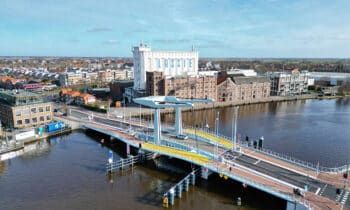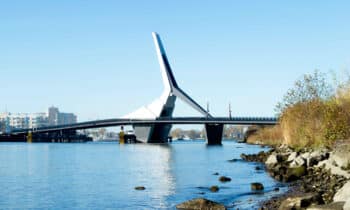
Start signal for eco valley on N76 in Oudsbergen
Exactly two months after Flemish Minister of Mobility and Public Works Lydia Peeters and Flemish Minister of Environment Zuhal Demir gave the go-ahead for the construction of the Waaltjesbos ecoduct in Lommel, they together put the shovel into the ground for the eco valley under the N76 in Oudsbergen, near the Zwartberg slag heap. Jan De Nul Group is building the eco valley on behalf of De Werkvennootschap.
Flanders is fully committed to the construction of defragmentation measures such as wildlife fencing, ecoducts, ecotunnels and ecopassages. Minister Lydia Peeters: "We want to 'de-fragment' all over Flanders and reconnect our important nature areas along regional and highways. We are doing this with all kinds of measures. From wildlife fences to ecoducts, ecotunnels, ... Here in Oudsbergen it will be an eco valley of no less than 65 meters wide. So we are very happy that we can start the works today. In 2021, ecorasters and a wildlife detection system were already installed at this location to increase traffic safety, but with the construction of the eco-valley, the picture is now complete. In a few years, the natural areas along the N76 will once again form one large whole. The further rollout of these defragmentation measures should also prevent dangerous traffic situations involving crossing wildlife. In this way, we also reduce injury accidents on our roads."

The 65-meter-wide eco-valley should reconnect nature on both sides of the road. The N76 will be placed on piers, allowing the landscape to pass under the road. The ecorasters placed along the road in 2021 connect to the ecovalley on both sides. In this way, animals will find their way safely to the crossing. In addition, the slopes of the valley face south. This creates a warm microclimate, which is ideal for local flora and fauna. Minister Zuhal Demir: "In densely built-up Flanders, nature reserves are still far too fragmented, dividing them into many small islands. Thanks to projects like this eco valley, we are turning the Hoge Kempen National Park, our pride in Limburg, back into one continuous whole. It gives a boost to biodiversity, greenery, livability and traffic safety."
Jan De Nul Group is responsible for the design, permitting and construction of the eco-passages and is being assisted by engineering firm Sweco. The works on the eco-valley will last approximately one and a half years, until the summer of 2025. Geert Versweyveld, Operations Manager Civil Works at Jan De Nul Group: "We are delighted to kick off the second sustainable project in the province of Limburg. In Lommel, the works for the Waaltjesbos ecoduct are already progressing nicely. Now we are starting this ecovalley in Oudsbergen. Both ecopassages are an example of how we give back space to fauna and flora in an urbanized area in a safe way for people and nature. Together with our partner Sweco, we have designed a beautiful and future-oriented concept and we are already looking forward to handing both projects over to nature in 2025."
Thanks to funding from the European Union (NextGenerationEU) in the framework of the Flemish resilience project VV105 (defragmenting Flemish landscape), this project can also be implemented quickly.




